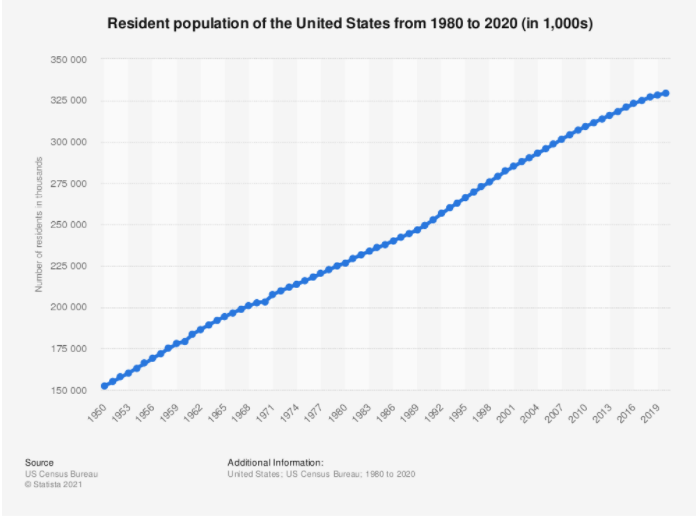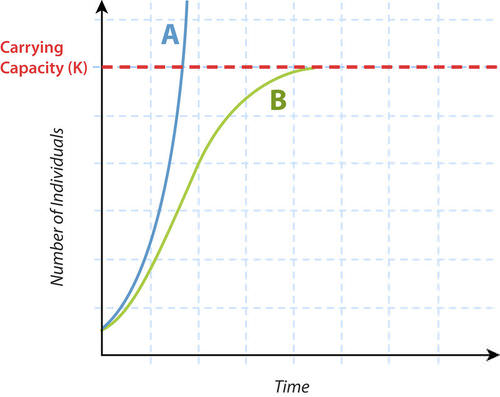Population Growth and Growth Patterns Study Guide
Introduction
Ecologists who study populations use several mathematical methods to understand the growth patterns of any given population of organisms. The increase in the population of any group of organisms depends on a number of factors that decide the population growth curve. Based on the parameters of the equations, accurate predictions can be made about how quickly the numbers can increase and where it tapers off.
Population Growth
- In simple terms, population growth refers to the number of individuals in the group as the population keeps increasing.
- Mathematical models that study the population growth rate (r) indicate how fast a population increases or decreases. The population growth curve is determined for any given population based on the rate.
Factors That Determine the Growth Rate
The population growth depends on factors such as birth rates, death rates, and migration. A simple mathematical relation can determine the growth rate:
Growth Rate (r) = Birth rate – Death rate
As long as the birth rate is higher than the death rate, the population growth is positive (increasing). When the death rate is higher than birth rates, the population growth begins to decline.
Other factors that influence growth rate include:
- How periodically the organism reproduces
- Age of the organism at first reproduction
- Number of offspring
- The type of parental care
- How long the organism is capable of reproducing
- The survival rates of the offspring
What are the different population growth curves?
There are two types of growth curves: the j shaped growth curve and the s-shaped growth curve. Both the types of growth curves fit population growth models that have different environmental pressures.
Exponential growth
One of the easily observable examples of exponential growth occurs in bacteria that divide rapidly within an hour. If there are 1000 bacteria on a plate, in the next hour, there will be 2000. In the 3rd hour, there will be 4000 bacteria, and by the 4th hour, there will be 8000. The characteristics of exponential growth are:
- They occur in ideal environments where the resources are relatively unlimited.
- There is no competition or limit to the exponential growth
- The population starts small and grows rapidly as time progresses, giving a J-type exponential growth curve.
- Exponential growth usually occurs in regions that have newly been colonized.
Logistic growth
Logistic growth is seen in most populations living in realistic conditions with limited space and resources. Since neither space nor resources are infinite, the growth rate starts to taper as the population density reaches a stage where it runs out of food or is poisoned by its waste.
The characteristics include logistic growth curve:
- Start rapidly as a J curve and flatten as it curves hits the environment’s carrying capacity.
- Carrying capacity refers to the maximum population of a species the environment can support.
- As the population reaches the carrying capacity (denoted by k), the curve begins to take an “S” shape.
- Logistical growth is seen in all stable populations living in a finite geographic area.
Growth factor selection in population growth forms
In living in stable environments, the population growth is controlled by the carrying capacity factor (k). As shown in the figure for logistic growth, these organisms have populations that are k-selected. Their numbers increase until the point where the population tapers off as the limits of space and resources are reached.
In populations that live in unstable environments where the whole population can be disturbed or destroyed in a short time, the growth pattern is said to be r-selected. The variable r is the growth rate defined earlier as the difference between the birth and death rates. The (r) usually corresponds to the first part of the exponential growth curve before the growth is interrupted/reset by unstable environmental factors.
Conclusion:
- Growth patterns of populations can be exponential under conditions where space and resources are infinite.
- Realistic growth patterns are limited by resource constraints and follow an S-shaped pattern.
- Exponential grown is mostly observed in microbial species.
- Exponential growth can be initially observed in newly colonized places until the limits of resources are reached.
FAQs:
1. What is a growth pattern?
A growth pattern refers to the population curve of a species. Depending on the limiting factors of the environment, the curve follows a specific shape such as a J or an S curve.
2. What are the four main patterns of population growth observed in nature?
The 4 main types of growth patterns include:
- J- pattern growth: This is an exponential growth pattern seen mostly in microbes and rarely in other organisms. The exponential growth of population produces a ”J” shaped curve on the size vs. generations graph.
- Logistical Growth: Logistical growth pattern is a realistic growth pattern of a population living in a finite space with finite resources. The pattern follows the logistic growth curve, which resembles an S.
- Temporal Growth patterns: Growth patterns in some populations are determined by periodic events such as seasonal changes. Such populations are said to be influenced by time.
- Predator-Prey growth patterns: These are the types of growth curves seen in organisms where the prey population is controlled by the population of predator and vice versa.
3. What is the pattern of population growth in the world?
The world is currently seeing a declining growth pattern, and it went down from a 2.2% decrease per year 50 years ago to 1.05% per year at present.
4. Why is population growth important?
Population growth is important because the aging population increases every year, and there will be economical implications. A steady working population is needed to keep the economy running smoothly.
We hope you enjoyed studying this lesson and learned something cool about population growth and growth patterns! Join our Discord community to get any questions you may have answered and to engage with other students just like you! Don’t forget to download our App to experience our fun, VR classrooms – we promise, it makes studying much more fun! 😎
Sources:
- Population Growth. https://ib.bioninja.com.au/options/option-c-ecology-and-conser/c5-population-ecology/population-growth.html. Accessed 3 Dec, 2021.
- Population Growth Patterns. https://www.ck12.org/book/ck-12-biology-concepts/section/6.20/. Accessed 3 Dec, 2021.
- Population Growth Patterns. https://flexbooks.ck12.org/cbook/ck-12-middle-school-life-science-2.0/section/12.4/primary/lesson/population-growth-patterns-ms-ls/. Accessed 3 Dec, 2021.
- Population Growth and Regulation. https://opentextbc.ca/conceptsofbiologyopenstax/chapter/population-growth-and-regulation/. Accessed 3 Dec, 2021.
- What Are the Three Phases of Logistic Growth?. https://sciencing.com/three-phases-logistic-growth-8401886.html. Accessed 3 Dec, 2021.
- World Population Growth. https://ourworldindata.org/world-population-growth. Accessed 3 Dec, 2021.


